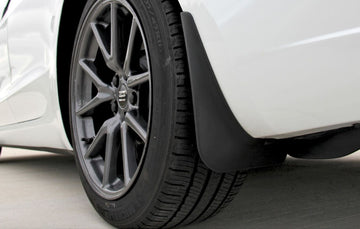Driving tips for maximizing mileage:
- Reduce the speed of the vehicle and avoid frequent and violent acceleration. Consider controlling acceleration and speed with Ease mode (see Controls) and Speed Assist (see Speed Assist).
- When safe to do so, adjust the accelerator pedal instead of depressing the brake pedal when decelerating. Whenever Model Y is in motion and the accelerator pedal is not depressed, regenerative braking slows Model Y and feeds remaining energy back to the battery (see Regenerative Braking).
- Set Stop Mode to Hold to benefit from regenerative braking at low driving speeds (see Stop Modes).
- Keep tires at recommended inflation pressure (see Tire Care), make sure tires are positioned within specification, and rotate tires as needed. Tire rotation reduces uneven tread wear and increases vehicle efficiency (see Maintenance Schedule).
- Lighten the load by removing any unnecessary cargo.
- Raise all windows fully.
- Conserves energy such as heating, lights and air conditioning. It is more effective to use seat heaters to keep warm than to use climate control to heat the interior of the vehicle.
- Use the phone app to preset the vehicle temperature to ensure the cabin is at a comfortable temperature and the windows are defrosted (if required) before driving by tapping Climate Controls > Open Climate Controls and customizing to personal preference (see Mobile App program).
- Tap Schedule (this setting is available on both the Charging and Climate Controls screens) to set how long you want your vehicle to be ready to drive (see Scheduled Charging and Timed Departure).
- Tap Schedule (this setting is available on both the Charging and Climate Controls screens) to set how long you want your vehicle to be ready to drive (see Scheduled Charging and Timed Departure).
- To prevent excessive power consumption when the vehicle is idle, charge the vehicle when not in use.
- For optimal battery performance, use DC chargers (such as Superchargers) as little as possible.
Factors affecting energy consumption:
Uphill: Driving uphill requires more energy and uses up the range faster. However, when driving uphill, the vehicle can regain some of the energy expended by regenerative braking (see regenerative braking).
Custom settings: Lights, heating and cooling, media player, sentry mode, etc. Ancillary apps consume energy.
Short trips: When starting the vehicle, energy is required to heat the cabin and battery to a specified temperature. With climate control activated, the average energy consumption may be higher if the vehicle has been driven very short distances.
Temperature and weather conditions: In colder weather, preset the vehicle temperature before driving (see Cold Weather Best Practices).
While parked, Model Y uses about 1% of its battery per day. In some cases (depending on vehicle settings), power consumption may be higher. To reduce energy consumption, turn off settings such as climate control, sentry mode, temperature presets (when the vehicle is not powered), and any aftermarket equipment that is not needed.
Mileage
The displayed range may drop faster than the actual distance traveled. When fully charged, Tesla vehicles display range based on EPA certification and do not take into account your driving habits or external conditions. To see estimated range based on energy consumption, open the Energy app to display the energy consumption graph. As with all vehicles, the actual range that Model Y can achieve depends heavily on driving habits and environmental conditions.
Energy app
The Energy App provides a visual representation of the vehicle's real-time and projected energy usage. To use the Energy app, navigate to App Launcher > Energy on the touchscreen. There are two graphs to choose from: Energy Consumption:
Shows how much energy Model Y has consumed over the past 10, 25, or 50 kilometers. Click on Immediate Mileage or Average Mileage to adjust future estimated mileage. Mileage Now uses only a small number of recent data points to estimate mileage, while Mileage Average provides a more accurate mileage estimate based on energy consumption over the past 10, 25 or 50 km.
Journey
Monitor the amount of energy used during navigation to your destination. You can track actual usage compared to initial projected usage. Green lines represent actual usage and gray lines represent projected usage. To change the zoom level, click the zoom icon in the upper right corner of the graph.
Note: The Range graph only shows energy usage when you use the navigation to go to a destination.
Mileage guaranteed
Tesla helps provide protection from running out of battery. Your vehicle continuously monitors charge level and proximity to known charging locations. When there is a risk of driving out of an area covered by known charging locations, a message will appear on the touchscreen prompting you to view a list of charging locations in the area. When you select a charging location from the list, Model Y can provide navigation instructions, and the list of route planning instructions can show the remaining charge when you arrive at the charging destination.Trip planner (if equipped) will route you through Superchargers to minimize travel and charging time. To enable, enter an address in the navigation search bar and open Trip Planner (see Trip Planner).
















































